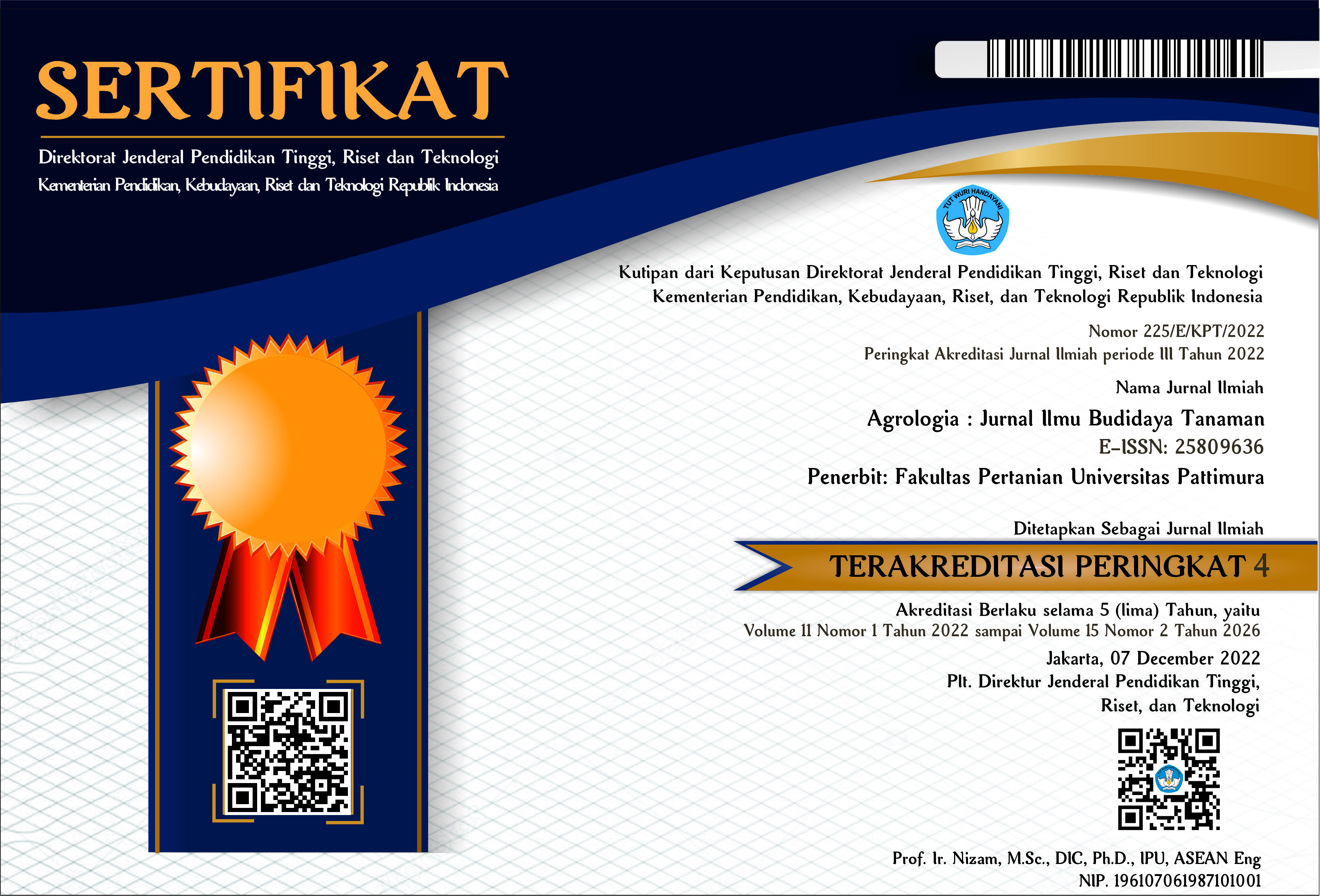Control of Damping off and Increased Growth of Tomato Seeds by Utilizing Trichoderma harzianum Based on Solid Organic Materials
Abstract
Low soil fertility and the presence of damping off disease which is a inhibiting factor in the nursery of tomato plants. This can be overcome by utilizing the biological agent Trichoderma harzianum based on solid organic matter (Trichocompost). The aim of the study was to determine the effect of giving Trichocompost and obtain the optimal Trichocompos dose to reduce the intensity of damping off disease and increase the growth of tomato seedlings. The treatments tried were Trichocompos with doses of 20, 40 and 60 tons/ha, designed using a complete randomized design with 10 replications. The plant response observed was the intensity of the disease; height, fresh weight and dry weight of canopy; length, fresh weight and root dry weight. The results showed that the monitoring of Trichocompost can reduce the intensity of damping off disease to 54.80% and increase the growth of tomato seedlings. The recommended Trichocompos dosage is 60 tons/ha or as much as 30 g/1 kg of soil. The results of this study can be used to increase agricultural production and also a solution in an environmentally friendly and sustainable farming system.
Keyword: Biocontrol, Tomato Trichocompos, Trichoderma harzianum
Full Text:
PDFReferences
Kalay, A.M., Hindersah R., Talahaturuson, A., dan A.I. Latupapua. 2017. Dual Anikulation of Azotobacter chroococcum and Trichoderma harzianum to Control Leaf Blight (Rhizoctonia solani) and Increase Yield af Choy Sum. IJSER 8 (6):1288-1292.
Putinela. J. A., W. Rumahlewang dan R. Hinderzah. 2016. Formulasi Inokulum Azotobacter-Trichoderma Berbasis Kompos Ela Sagu Untuk Peningkatan Produksi Tanaman Sayuran di Waiheru Ambon. Laporan Penelitian Kerjasama Antar Perguruan Tinggi.
Kalay, A. M., Talahaturuson, A., Hinderzah dan Y. Lakbulawar. 2015. Berbagai Metode Aplikasi Azotobacter chroococcum Untuk Menekan Penyakit Dumping Off untuk Busuk Daun Kacang Panjang. Prosiding Seminar Nasional Dan Kongres XXIII Perhimpunan Fotopatologi Indonesia. Penerbit: Perhimpunan Fitopatologi Indonesia. Komisariat DKI Jakarta. 147-158.
Purchase, D. 2016. Fungal Applications in substainable environmental biotechnology. Springer London.
Harman, G. E. 2006. Overview of Mechanims and Uses of Trichoderma spp. Phytopathology 96:190-194.
Mukerji, K.G. and K.L. Grag. 2000. Biocontrol of Plant Disease. 2nd. CRC Press Inc. Florida
Rini, C.R and K.K. Sulochana.2007. Usefulness of Trichoderma and Pseudomonas against Rhizoctonia solani and Fusarium oxyporium infecting tomato. Journal of Tropical Agriculture 45 (1-2):21-28
Santiaji. B dan H.S. Gusnawaty. 2007. Potensi Ampas Sagu Sebagai Media Perbanyakan Jamur Agensia Biokontrol Untuk Pengendalian Patogen Tular Tanah. J. Agriplus 17: 20-25.
Liu, J. B., Gilardi, G., Gullino, M.L and A. Garibaldi.2009. Effectiveness of Trichoderma spp. Obtained from re-used soilless substrates against Phytium ultimum on cucumber seedlings. Journal of plant Diseases and Protection, 116 (4), 156-163.
Hanada, R.E., Pomella, A.W.V., Soberanis, W., Loguerico, L.L and J.O. Pereira. 2009. Biocontrol potential of Trichoderma martial against the black-pod disease (phytophthora palmivora) of cacao. Biological Control 50: 143-149.
Purwantisari, S dan R.B. Hastuti. 2009. Uji Antagonisme Jamur Pathogen Phytophthora infestans Penyebab Penyakit Busuk Daun Dan Umbi Tanaman Kentang Dengan Menggunakan Trichoderma Spp. Isolate Lokal. BIOMA 11 (1):24-32.
Supriati, L,. Mulyani, R.B dan Y. Lambang.2010. Kemampuan Antagonisme Beberapa Isolat Trichoderma sp. Indigenous Terhadap Sclerotium Rolfsii secara invitro. Agroscientiae 17 (3): 119-122.
Kalay, A.M. 2006. Pengujian Tiga Spesies Jamur Sebagai Agens Hayati Pengendali Globodera Rostochiensis (woll.). j. Peng. Wil. 2:116-121.
Eapen, S.J., Beena, B and K.V. Ramana. 2009. Field evalution of Trichoderma harzianum, Pochonia chlamydosporia and Pasteuria penetrans in a root knot nematode infested black pepper (Piper nigrum L.) garden in india. Journal of Plantatoin Crops 37 (3): 196-200.
Hardjowigeno, S. 2007. Ilmu Tanah. Akademika Presindo: Jakarta.
Kalay, A.M dan A.Talahaturuson. 2014. Perbanyakan Trichiderma harzianum pada Media Nerbasis Ela Sagu. J. Agroteknologi 6 (2): 105-113.
Natawigane HH.1994. Dasar- Dasar Perlindungan Tanaman. Penerbit Trigenda Karya Bandung.
Elad Y and S. Freeman. 2002. Biological Contol of Fungal Plant Pathogens. In: Kempken F (ed) The Mycota, A omprehen-sive Treatise on Fungi as Experimental Systems For Basic and Applied Research. XI. Agricultural Applications, Springer, Heidelberg, Germany, pp. 93-109.
Schubert, M., Fink, S and F.W.M.R. Schwarzel. 2008. In vitro screening of an antagonistic trichoderma strain against wood decay fungi. Arboriculture journal 31: 227-248.
Ha, T. N. 2010. Using Trichoderma Species for Biological Control Of Plant Pathogens in Vietnam. J. ISSAAS 16 (1): 17-21.
Lynch, J.M. 1987. In Vitro Identifications of Trhicoderma harzianum as a Potential Antagonistic of Plant Pathogens. Current Microbial. 16: 49-53.
Chet, I., 1990. Biological Control of Soil-Born Plant Pathogens With Fungal Antagonists In Combination Wiyh Soil Treatments. D Hornby (Ed): Biological Control of Soil Born Plant Pathogens. Wallington C.A.B. International.
Herlina, L. 2009. Potensi Trichoderma harzianum Sebagai Biofungisida Pada Tanaman Tomat. Jurnal Biosaintifika 1:1. 62-69.
Backer, K. F., and Cook, R. J. 1983. Nature and Prctice of Biological Control of Plant Phatogens. Minnesota: The American Phytopathologi.
Irwansyah, A. 2008. Penggunaan Beberapa Jenis Aktivator Untuk Meningkatkan Laju Degradasi Tanah Gambut dan Pertumbuhan Tanaman Jatih Putih (Gmelina arborea roxb). [Skripsi]. Universitas Sumatera Selatan. Medan.
Esrita, B. Ichwan dan Irianto. 2011. Pertumbuhan dan Hasil Tomat Pada Berbagai Bahan Organik dan Dosis Trichoderma. Jurnal Penelitian Universitas Jambi Seri Sains 13 (2):37-42..
Yuleli, 2009. Penggunaan Beberapa Jenis Fungi Untuk Meningkatkan Pertumbuhan Tanaman Karet (Havea brasilliensis) di Tanah Gambut. Universitas Sumatera Utara.
Jayalakshmi, S. K., Raju, S., Usha-Rani, S., Benagi, V.I. and K. Sreeramulu. 2009. Trichoderma harzianum L1 as a potential source for lytic enzymes and elicitor of defense responses in chickpea (Cicer arietinum L.) against wilt disease caused by Fusarium oxysporum f. sp. Ciceri. Australian Journal of Crop Science 3 (1): 44-52.
Martines-Medina. A., Alguicil. M.D.M., J. A. Pascual dan S.C.M. Van Wess. 2014. Phytohormkne Profiles Induced by Trichoderma Isolates Correspond With Ther Biocontrol and Plant Growth-Promoting Activity on Melon Plants.
DOI: http://dx.doi.org/10.30598/a.v8i1.873
Refbacks
- There are currently no refbacks.











